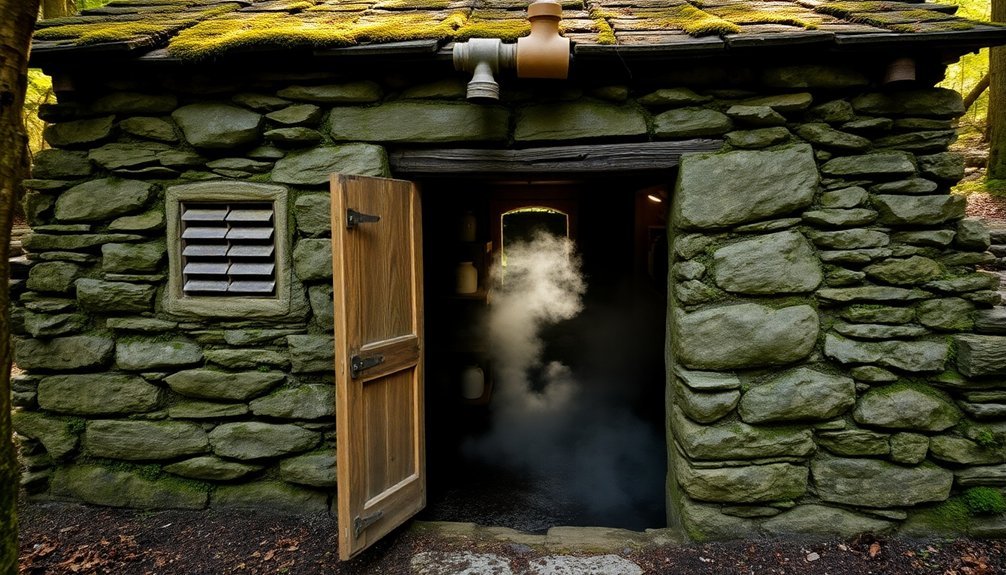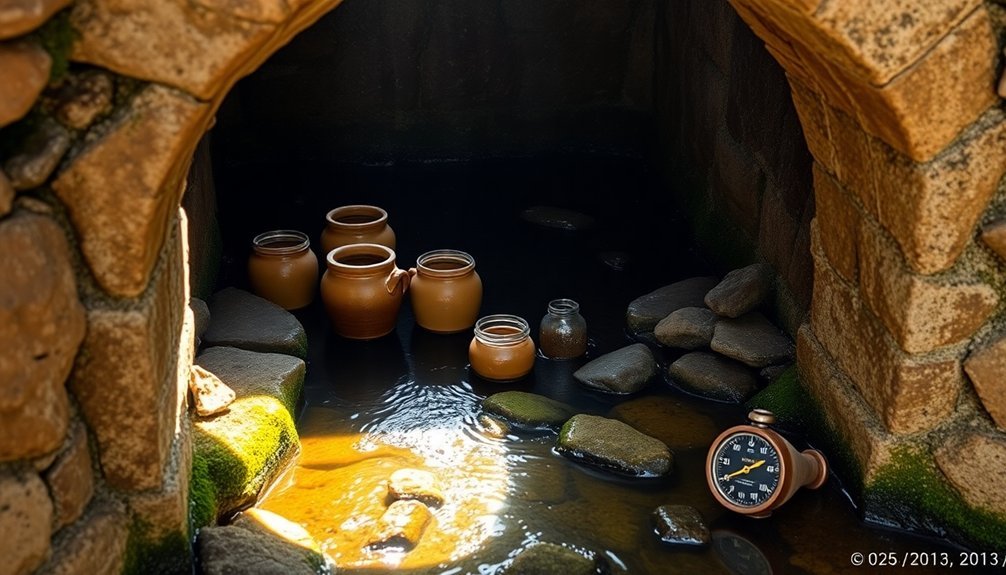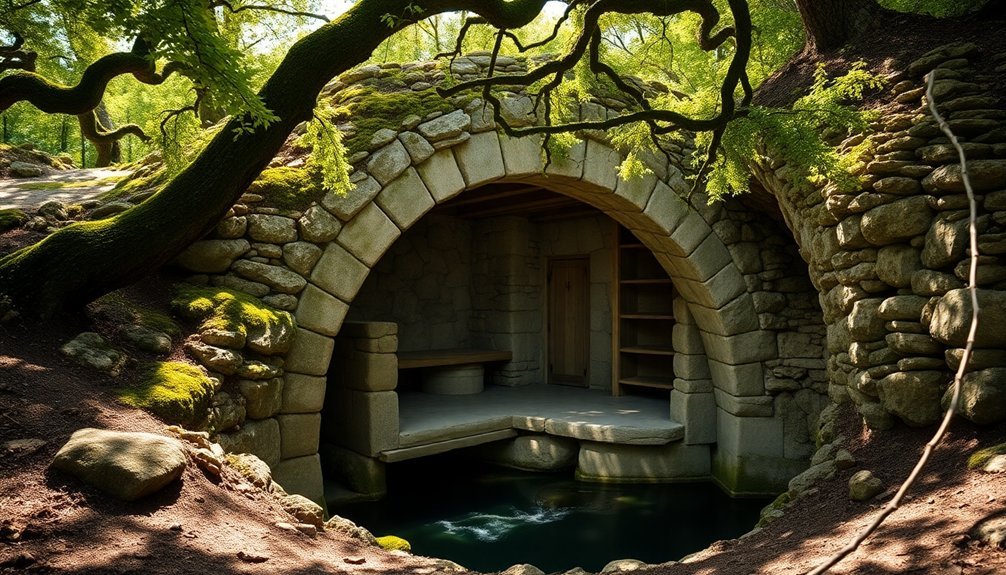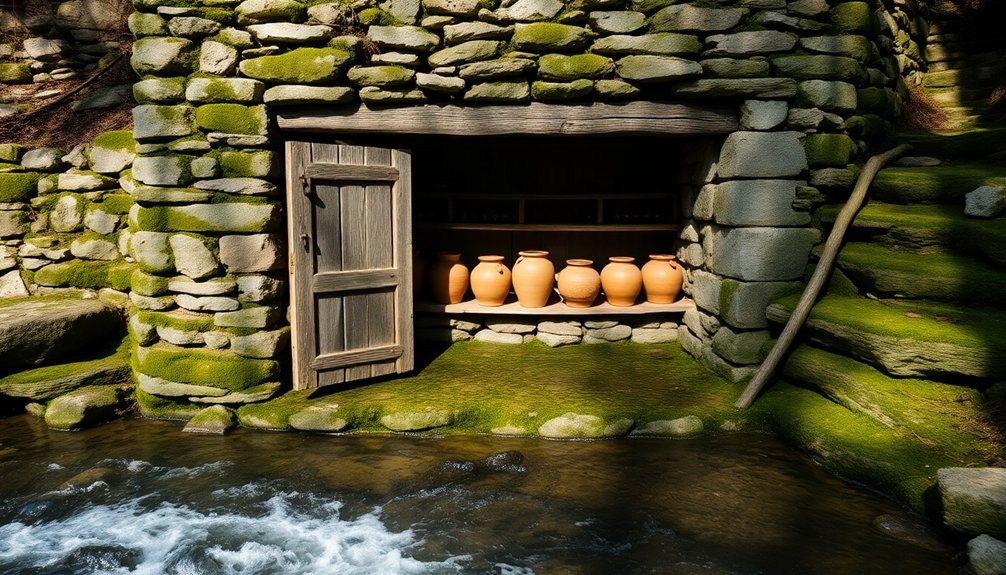Spring houses keep your food cold year-round through a clever combination of natural cooling systems. You'll find they maintain a steady 50-55°F temperature by utilizing spring water's consistent coolness and the earth's natural insulation properties. The thick stone walls, typically built into hillsides, work with strategic air flow designs to create natural convection currents. Cold spring water flows through channels while warm air rises and exits through vents, establishing a self-regulating cooling system. This traditional method has worked effectively for centuries without mechanical refrigeration, and there's much more to discover about these ingenious preservation structures.
Natural Underground Cooling Systems
Harnessing the earth's natural cooling properties, earth tubes provide an ingenious solution for regulating indoor temperatures. You'll find these tubes buried 1.5 to 3 meters underground, extending 30 to 50 meters in length, where they tap into the earth's constant temperature to cool your indoor spaces by 10 to 20 degrees Fahrenheit.
The system's brilliance lies in its simplicity. You don't need pumps or fans – natural convection does all the work. As warm air enters through a filtered intake, it travels through the underground tubes, where it cools and dehumidifies. Research shows these systems can reduce energy costs by 23% in large office buildings.
The pressure difference created by this process draws the cooled air into your building while expelling hot air through high windows.
You're actually using technology that's been refined over centuries. The Romans and ancient Middle Eastern civilizations used similar principles, incorporating underground waterways and vertical shafts to cool their buildings.
Today's earth tubes maintain this low-tech approach while offering modern benefits: they'll last 25+ years with minimal maintenance, considerably reduce your energy bills, and provide an environmentally friendly alternative to traditional cooling systems.
With proper installation, including a sloped design for condensation drainage, you'll have a reliable cooling system that works year-round.
Spring Water Temperature Control
You'll find that spring houses maintain their cooling power through the constant flow of natural spring water, which stays at a steady 50 degrees Fahrenheit year-round.
The water's temperature remains unchanged thanks to the earth's natural insulation properties, creating a reliable environment for food preservation.
You can count on this natural temperature regulation system to work continuously without mechanical intervention, making spring houses an effective method for keeping perishables cool before modern refrigeration. The structures were constructed with thick stone walls that provided additional insulation to maintain the cool temperatures inside.
Natural Temperature Regulation
The cornerstone of a springhouse's effectiveness lies in its natural temperature regulation system. You'll find that spring water maintains a remarkably consistent temperature of around 50 degrees Fahrenheit throughout the year, regardless of outside weather conditions. This natural phenomenon creates an ideal environment for preserving perishable foods without artificial refrigeration.
When you're storing food in a springhouse, you'll benefit from several key temperature regulation features:
- Spring water's temperature remains steady year-round, helping prevent food spoilage
- Cold water channels actively cool items placed directly in them, especially dairy products
- The enclosed structure traps cool air, maintaining temperatures 10 degrees below outside levels
- Natural insulation from ground and spring water creates a stable preservation environment
- Ambient air circulation keeps food fresh even when not in direct contact with water
The combination of flowing spring water and trapped cool air works together to create a dependable cooling system. Spring-fed wells provided essential drinking water for daily household needs.
You'll notice that items stored in earthenware crocks placed directly in water channels stay especially cold, while other foods benefit from the consistently cool air temperature throughout the structure. This dual cooling approach guarantees your food stays preserved naturally.
Constant Cold Water Flow
Building upon the natural cooling system, a well-designed spring water flow network forms the heart of effective temperature control in spring houses. You'll find that proper pipe installation with a consistent slope of 1/8" to 1/4" per foot guarantees steady water movement throughout the system, maintaining ideal cooling conditions.
| Component | Function | Maintenance |
|---|---|---|
| Spring Box | Captures and directs water flow | Regular cleaning to prevent blockages |
| Inlet Pipes | Channels spring water into system | Check for proper slope and clear debris |
| Discharge Pipes | Controls main water outflow | Monitor for consistent flow rate |
| Overflow Pipes | Prevents pressure buildup | Guarantee unrestricted drainage |
The spring's natural cold water flows through carefully designed channels, creating cooling zones where you can store perishable items. You'll want to maintain these channels regularly to prevent flow disruptions that could affect temperature control. By positioning food items directly in or above the water channels, you're taking advantage of the spring's constant cold temperature. If you notice reduced flow or temperature fluctuations, check the pipe slopes and clear any obstructions to restore ideal performance. Remember, proper maintenance of your spring house's water flow system is essential for consistent food preservation.
Air Flow Design
The thermal circulation patterns in spring houses create a natural cooling system, as you'll find warm air rising and cool air settling near the floor level.
Ventilation through the thick stone walls allows for controlled air exchange, with strategically placed openings that help maintain consistent temperatures throughout the structure.
The cross-draft cooling system enhances this effect by drawing fresh air across stored items, ensuring your food stays preserved in the ideal environment.
Thermal Circulation Patterns
Through careful design and implementation, thermal circulation patterns play an essential role in spring house ventilation. You'll find that these patterns rely heavily on the stack effect, where temperature differences create natural air movement.
Cool air enters at lower levels, while warmer air naturally rises and exits through higher openings, creating a continuous circulation pattern that keeps food preserved.
When you're designing a spring house, you'll need to work with these natural thermal patterns rather than against them. The strategic placement of intake and exhaust points maximizes this effect, guaranteeing consistent airflow throughout the structure.
- Cool air enters through lower vents near the water source
- Warmer air naturally rises toward the ceiling
- Cross-ventilation creates horizontal air movement
- Night-purge ventilation cools the structure during evening hours
- Solar chimneys enhance vertical air movement during daytime
You can optimize these patterns by incorporating demand-controlled fans and balancing dampers when natural ventilation needs assistance.
The key is to maintain consistent air movement while protecting against unwanted temperature fluctuations. This careful balance of thermal circulation guarantees your spring house maintains ideal preservation conditions throughout the year.
Ventilation Through Stone Walls
Within stone walls of spring houses lies a complex ventilation system that relies on both intentional design and natural characteristics of the materials. You'll find these thick stone walls, typically 1-2 feet wide, constructed from local materials that naturally allow minimal air movement through their porous structure. The deliberate inclusion of small channels and pipes enhances this natural ventilation while directing water flow to maintain consistent temperatures.
You won't see modern ventilation features in these structures, but that's intentional. The stone walls work with natural pressure differences between the interior and exterior, creating subtle air circulation patterns.
When you examine the construction closely, you'll notice how the walls are often built into hillsides, using the earth's natural insulation while allowing for strategic airflow through carefully placed gaps.
The walls' thickness and composition play an essential role in managing moisture levels. While today's buildings rely on mechanical ventilation, spring houses use the inherent properties of stone and strategic placement of water channels to create a balanced environment.
This natural approach to air circulation helps maintain the cool, controlled conditions necessary for food preservation without requiring modern technology.
Cross-Draft Cooling System
Moving through a spring house, you'll find an ingenious cross-draft cooling system that harnesses natural convection and wind patterns to maintain consistently cool temperatures. The system works by strategically placing openings on opposite sides of the structure, allowing cool air to enter while warm air exits.
You'll notice how the natural pressure differences created by temperature variations drive this circulation, eliminating the need for mechanical fans.
- Cold air stays low near the spring water, creating a natural cooling reservoir
- Warm air naturally rises and exits through upper vents
- Strategic window and door placement maximizes wind-driven ventilation
- Prevailing winds create positive pressure on entry points
- Negative pressure on exit points guarantees continuous airflow
When you explore the structure's design, you'll see how it enhances thermal comfort through constant air movement. The cool spring water at the base maintains a consistently low temperature, while the cross-draft system efficiently distributes this coolness throughout the space.
This natural cooling method proved so effective that spring houses served as primary food preservation structures before modern refrigeration, keeping perishables fresh year-round through this elegant combination of water cooling and air circulation.
Passive Cooling Methods
Since ancient times, passive cooling methods have relied on natural principles to maintain comfortable indoor temperatures without mechanical systems.
You'll find these techniques maximize natural air movement, utilize thermal mass, and incorporate strategic design elements.
You can harness natural air movement by designing spaces with well-placed openings that capture cool breezes and create air-pressure differentials. In areas with low humidity, you'll benefit from evaporative cooling, especially when you incorporate water features that pre-cool incoming air.
Thermal mass plays a vital role in temperature regulation. You'll want thick exterior walls that absorb heat during the day and release it outside at night. This method works particularly well in hot, dry climates where nighttime temperatures drop markedly.
To enhance these cooling effects, you'll need proper insulation in all exterior walls, floors above unconditioned spaces, and slab foundations.
You can further improve cooling by installing energy-efficient windows and adequate overhangs.
Don't forget about landscaping – strategic placement of evergreens and large trees provides essential shade, while carefully positioned water features increase evaporation rates in dry climates.
Essential Ventilation Components

Your spring house's ventilation system needs both carefully designed air flow features and reliable temperature control methods to maintain proper food preservation conditions.
You'll want to include motorized dampers with tight-sealing neoprene gaskets to regulate fresh air intake, similar to modern CFI ventilation systems that automatically adjust based on temperature requirements.
The strategic placement of these components, combined with balanced air exchange principles, helps you maintain consistent cooling while preventing unwanted humidity and temperature fluctuations that could compromise food storage.
Air Flow Design Features
Air flow design features work seamlessly with a spring house's natural water channels to create an efficient cooling system. You'll find that these structures don't need complex mechanical ventilation, as they rely on the natural movement of air created by water flow and strategic design elements.
The placement of openings and the interaction between cool water and ambient air creates a natural circulation pattern that keeps food fresh year-round.
- Small, single-room design maximizes the cooling effect of water flow
- Strategic placement of openings allows for peak air movement
- Natural ventilation occurs through the interaction of water and air
- Original doorless designs enhanced unrestricted airflow
- Modern adaptations include doors while maintaining ventilation
While modern refrigeration systems require electricity and mechanical components, spring houses achieve remarkable cooling through their thoughtful design.
The structure's small size guarantees that cool air from the water source reaches all areas effectively. When you combine this with the natural insulation from hillside placement and stone construction, you get a remarkably efficient preservation system.
The cool air from springs or creeks continuously circulates through the space, maintaining ideal temperatures without any mechanical intervention.
Temperature Control Methods
Building on the natural airflow principles, temperature control in spring houses relies on a sophisticated interplay of water flow and structural design. You'll find that the channeled spring water maintains a consistent mid-50°F temperature year-round, creating an ideal environment for food preservation. The flowing water absorbs excess heat, while the stone construction provides essential thermal mass.
| Feature | Function | Benefit |
|---|---|---|
| Water Channel | Directs spring flow | Constant cooling |
| Stone Walls | Thermal mass storage | Temperature stability |
| Limited Openings | Controls air exchange | Maintains cool air |
| Underground Elements | Natural cooling | Enhanced insulation |
| Elevated Storage | Air circulation | Better preservation |
You'll notice that the structure's design maximizes these cooling effects through strategic placement of storage areas. By positioning items on elevated shelves and utilizing the coolest zones, you're taking advantage of natural temperature stratification. The air-tight construction prevents warm air infiltration, while the controlled ventilation system guarantees that any necessary air exchange doesn't compromise the interior climate. This combination of water flow, structural materials, and precise air management creates an efficient, sustainable cooling system that works effectively throughout all seasons.
Historical Cooling Techniques
Throughout history, people came up with ingenious ways to keep their food fresh without modern refrigeration. The ancient Romans pioneered cooling systems by running cold aqueduct water through pipes in their walls, while Egyptians used dampened reeds and water pools to lower temperatures in storage areas.
You'll find these fascinating cooling methods used across different cultures:
- Spring houses built into hillsides using natural earth insulation
- Middle Eastern wind catchers that captured and directed cool breezes
- Internal courtyards with gardens and pools to create cooling airflow
- Dutch doors with split designs for controlled ventilation
- Strategic use of stone masonry and mud bricks for thermal insulation
You can see these principles at work in traditional spring houses, where food storage met clever engineering.
They're typically small, single-room structures with stone shelves and hooks for storing dairy products, meats, and vegetables.
The buildings were oriented to maximize natural ventilation, while their hillside placement and thick walls maintained steady temperatures.
Cold spring water running through the structure created a consistently cool environment that kept food fresh throughout the year.
Water Channel Engineering

Water systems in spring houses rely on precise engineering to maintain their cooling efficiency. You'll need to guarantee proper pipe slope between 1/8" to 1/4" per foot, with the pipe end nearest to the spring box elevated 1/2"-1" higher when using a 4-foot level. This downhill gradient prevents backup and maintains continuous water flow while avoiding back pressure on the spring.
For construction, you'll want to use schedule 40 PVC pipe, which offers excellent durability for underground applications. When connecting to existing pipes, flexible fernco connectors provide secure shifts, especially when integrating with cast iron pipes or different diameters.
You'll need to dig trenches along your planned layout, filling them with gravel underneath the pipe to maintain slope and prevent settling.
Your inlet pipes must enter the spring box above both discharge and overflow pipes. The discharge pipe should be at the lowest point for peak drainage, while overflow pipes serve as backup when the main discharge becomes blocked.
Don't forget to protect overflow pipe ends with mesh screens to keep out debris and small animals, and use UV-resistant materials for any exposed piping.
Temperature Regulation Features
A successful spring house relies on multiple temperature regulation features working in harmony. You'll find these structures cleverly designed to maintain temperatures around 50°F through natural cooling methods, without the need for artificial refrigeration.
When you examine a spring house's construction, you'll notice it's often built into a hillside or positioned over a spring. This strategic placement takes advantage of the earth's natural insulating properties, while proper ventilation guarantees consistent air circulation to prevent warm air and moisture buildup.
Here's what makes spring houses so effective at temperature regulation:
- Natural earth insulation shields the structure from external temperature fluctuations
- Strategic air circulation pathways prevent warm air from becoming trapped
- Careful placement in shaded areas blocks direct sunlight exposure
- Overhanging roofs and natural tree cover provide additional sun protection
- Proper food placement maximizes cooling efficiency through air flow
The placement of items within the spring house is equally important for temperature regulation. You'll see milk containers suspended from rafters and stoneware crocks positioned on floors or shelves, guaranteeing each item benefits from the cool air circulation while preventing spoilage.
Traditional Construction Materials

Building a spring house requires careful selection of durable, insulating materials that complement its temperature-regulating design.
You'll need sturdy concrete blocks or stone for the walls, paired with a reinforced concrete foundation that includes rebar to prevent cracking. These materials aren't just robust; they're excellent at maintaining consistent interior temperatures.
For the roof, you'll want to choose weather-resistant materials like metal or asphalt shingles that can withstand years of exposure to the elements.
It's essential to guarantee proper installation, as the roof's primary function is keeping the interior dry and cool while protecting the structure from rain and sun.
Your insulation choices can include fiberglass, cellulose, or spray foam, with eco-friendly options available if you're environmentally conscious.
Professional installation of insulation is often worth the investment, as it's vital for maintaining the spring house's cooling efficiency.
You'll also need to incorporate proper water management systems, including PVC pipes and trenches to control water flow.
Don't forget to build a retaining wall around the spring to keep dirt and debris from contaminating the water source.
Seasonal Storage Solutions
Storage solutions for seasonal produce depend heavily on maintaining consistent temperatures and proper humidity levels. Spring houses excel at this by naturally maintaining temperatures in the mid-50°F range, creating a perfect environment for preserving perishables throughout the year.
You'll find that different foods require specific storage conditions, and spring houses offer versatile solutions for various food types.
- Store dairy products and meats in the coolest areas to maximize their shelf life
- Use natural fiber and cotton produce bags to regulate moisture and promote airflow
- Place root vegetables in darker areas where they'll thrive in cool conditions
- Adjust humidity levels based on produce type – higher for items that wilt, lower for those prone to rotting
- Utilize channels and water flow to maintain ideal moisture levels naturally
If you don't have access to a spring house, you can still preserve your seasonal harvest using alternative methods.
Root cellars, pantries, and modern refrigeration systems can effectively store your produce. Consider using food dehydrators for long-term storage of fruits and vegetables, or freezing certain items after proper blanching.
Remember that each storage method should match the specific needs of your produce for perfect preservation.
Cold Air Circulation Patterns

Natural cooling in spring houses relies on carefully orchestrated air circulation patterns that work in harmony with flowing water. You'll find that the cool water flowing through channels along the interior walls creates a consistent temperature in the mid-50°F range, while the structure's design maximizes this cooling effect through strategic air movement.
The air circulation follows a predictable pattern: cool air enters through lower openings and vents, while warm air rises and exits through higher openings due to natural buoyancy. You'll notice that the building's design enhances this flow with tall ceilings and pitched roofs that help channel warm air upward and out. Louvered shutters and crawl spaces under the floorboards further contribute to this circulation system.
When you examine the structure's integration with its environment, you'll see how spring houses are positioned to capture prevailing winds and natural shade. The building's narrow design, deep porches, and overhangs work together to minimize direct sunlight.
Inside, built-in shelves and rafters are arranged to promote even air distribution, while stoneware crocks help maintain consistent temperatures throughout the space.
Spring House Layout Principles
Along the hillsides of early American homesteads, spring houses followed precise layout principles that maximized their cooling efficiency. You'll find these structures strategically built over natural springs, with thick stone walls extending into the hillside. This intentional positioning tapped into the earth's natural cooling properties while protecting stored food from predators and temperature fluctuations.
The layout fundamentals that made spring houses effective include:
- Single-room design sunken into the ground, creating a naturally cool environment
- Stone walls 1-2 feet thick, constructed from local materials found on the property
- Strategic water channels along interior walls to maintain consistent temperatures
- Integration with the hillside for maximum insulation and temperature control
- Carefully positioned doors and windows to manage airflow and accessibility
When you examine a spring house's construction, you'll notice how it's designed to work with the landscape rather than against it.
The structure's placement against a hill, combined with thick stone walls and smart water management, created an efficient cooling system that maintained temperatures around 50°F year-round, perfect for preserving dairy products, meats, and vegetables.
Frequently Asked Questions
How Long Did Food Typically Stay Fresh in a Spring House?
You can keep your food fresh in a spring house for several weeks to months. If you store items directly in the cold water channel, they'll last longer than those kept in the ambient air.
Could Spring Houses Be Used to Store Medicines and Medical Supplies?
You could store medicines in spring houses thanks to their consistent 50°F temperature and low humidity. They'll keep drugs stable and protected from light, though you'd need proper security and monitoring systems.
What Happened to Spring Houses During Droughts or When Springs Dried Up?
When your spring house's water flow diminishes during droughts, you'll lose its cooling function and may face structural issues. You'll need to find alternative storage methods or repurpose the space until water returns.
Did Native Americans Use Similar Structures Before European Colonization?
Yes, you'll find Native Americans used natural cold storage before colonization. They'd store food in lava tubes, ice cellars, and igloos. These structures maintained cool temperatures year-round, much like spring houses.
How Were Spring Houses Protected From Flooding During Heavy Rains?
You'll find spring houses were naturally protected from floods through their hillside location, effective drainage systems, and permeable ground surfaces. Their stone construction and elevated placement helped divert water away during heavy rains.
In Summary
You'll find that spring houses keep food cold through an ingenious combination of natural elements and smart design. By harnessing cool spring water, underground temperatures, and strategic airflow, you're able to maintain consistent cooling year-round. When you understand how stone walls, ventilation systems, and ground temperature work together, you've got an efficient, electricity-free storage solution that's been keeping food fresh for generations.





Leave a Reply